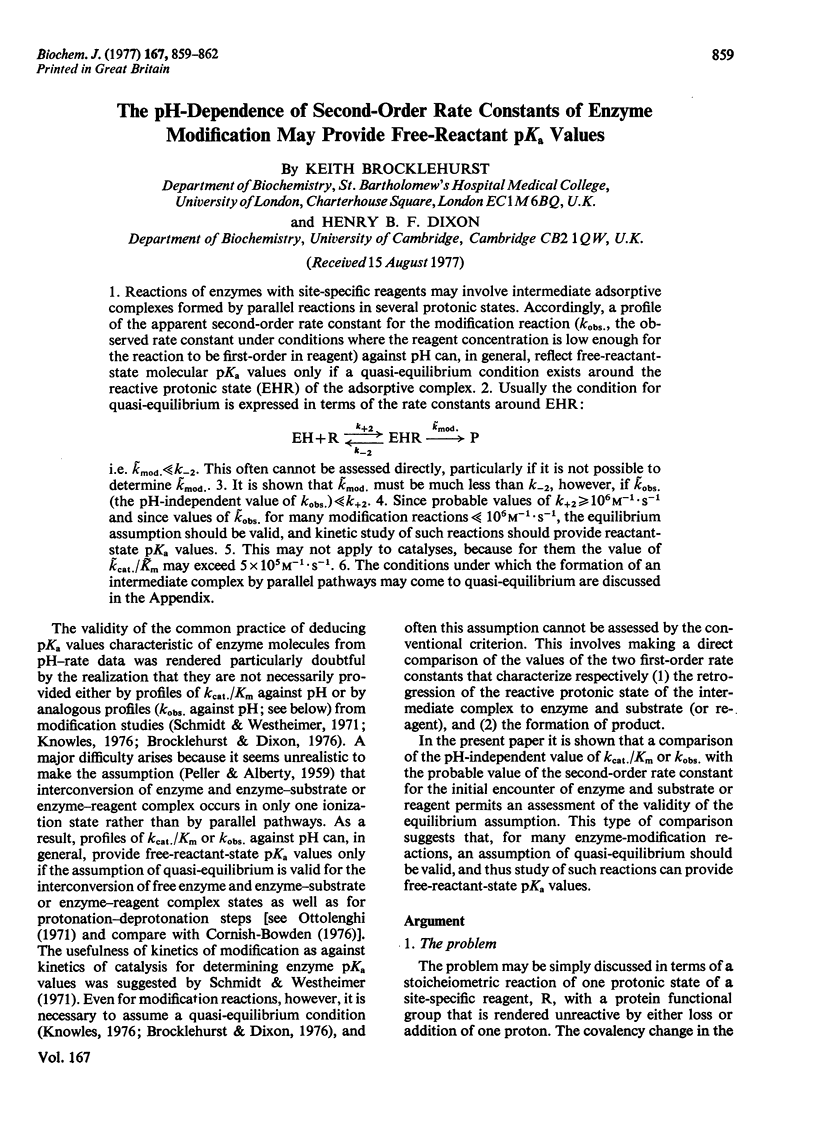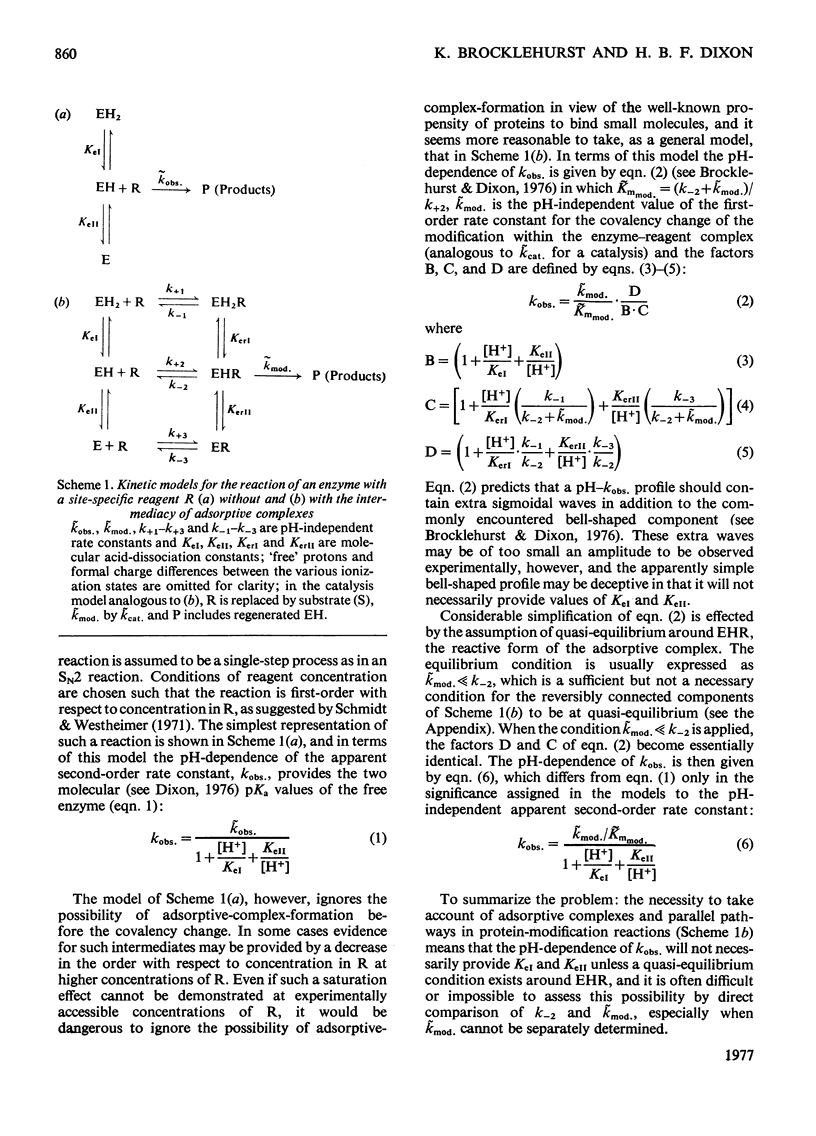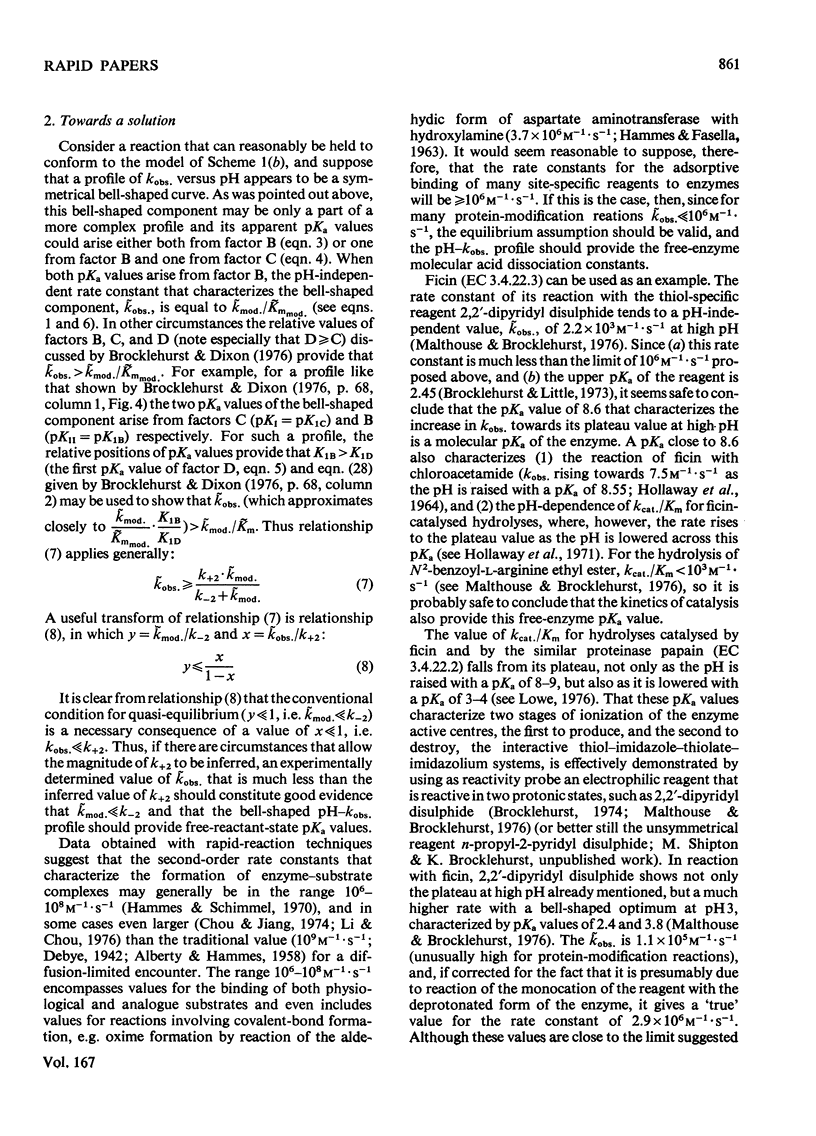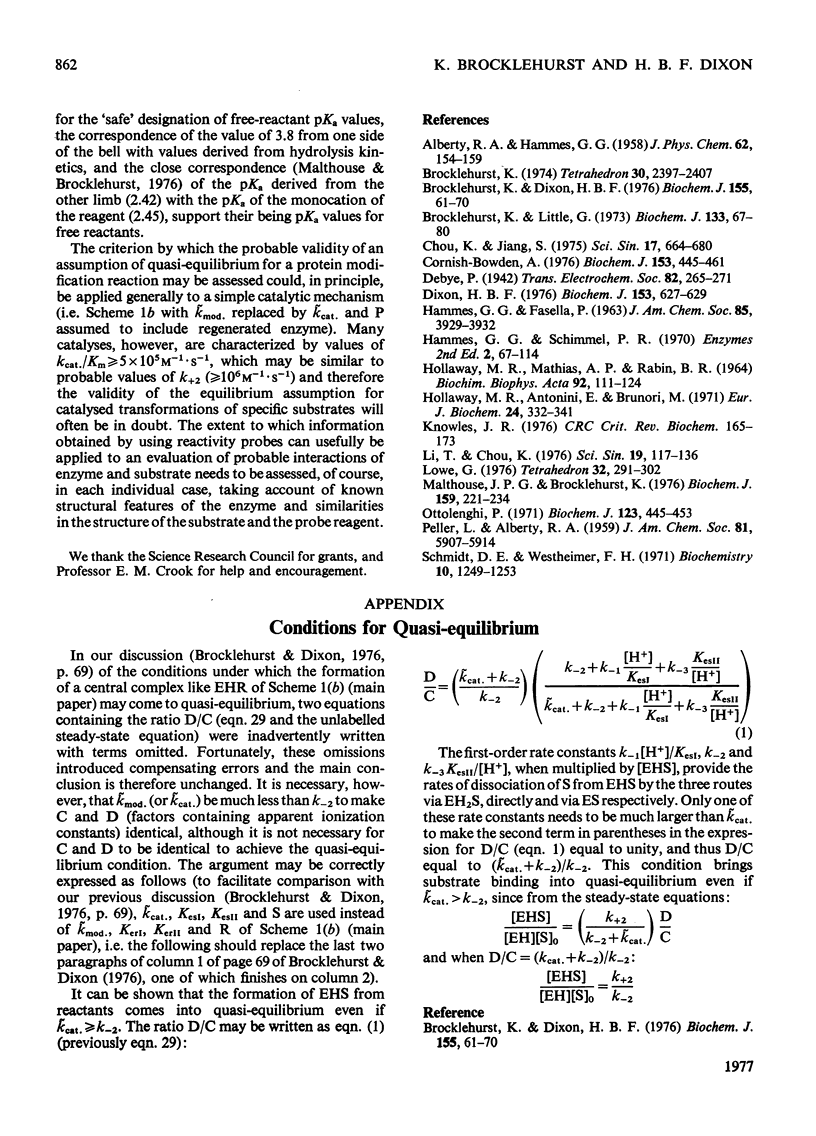Abstract
1. Reactions of enzymes with site-specific reagents may involve intermediate adsorptive complexes formed by parallel reactions in several protonic states. Accordingly, a profile of the apparent second-order rate constant for the modification reaction (Kobs., the observed rate constant under conditions where the reagent concentration is low enough for the reaction to be first-order in reagent) against pH can, in general, reflect free-reactant-state molecular pKa values only if a quasi-equilibrium condition exists around the reactive protonic state (EHR) of the adsorptive complex. 2. Usually the condition for quasi-equilibrium is expressed in terms of the rate constants around EHR: (formula: see text) i.e. k mod. less than k-2. This often cannot be assessed directly, particularly if it is not possible to determine kmod. 3. It is shown that kmod. must be much less than k-2, however, if kobs. (the pH-independent value of kobs.) less than k+2. 4. Since probable values of k+2 greater than 10(6)M-1.S-1 and since values of kobs. for many modification reactions less than 10(6)M-1.S-1, the equilibrium assumption should be valid, and kinetic study of such reactions should provide reactant-state pKa values. 5. This may not apply to catalyses, because for them the value of kcat./Km may exceed 5 X 10(5)M-1.S-1. 6. The conditions under which the formation of an intermediate complex by parallel pathways may come to quasi-equilibrium are discussed in the Appendix.
Full text
PDF



Selected References
These references are in PubMed. This may not be the complete list of references from this article.
- Brocklehurst K., Dixon H. B. PH-dependence of the steady-state rate of a two-step enzymic reaction. Biochem J. 1976 Apr 1;155(1):61–70. doi: 10.1042/bj1550061. [DOI] [PMC free article] [PubMed] [Google Scholar]
- Brocklehurst K., Dixon H. B. PH-dependence of the steady-state rate of a two-step enzymic reaction. Biochem J. 1976 Apr 1;155(1):61–70. doi: 10.1042/bj1550061. [DOI] [PMC free article] [PubMed] [Google Scholar]
- Brocklehurst K., Little G. Reactions of papain and of low-molecular-weight thiols with some aromatic disulphides. 2,2'-Dipyridyl disulphide as a convenient active-site titrant for papain even in the presence of other thiols. Biochem J. 1973 May;133(1):67–80. doi: 10.1042/bj1330067. [DOI] [PMC free article] [PubMed] [Google Scholar]
- Cornish-Bowden A. Estimation of the dissociation constants of enzyme-substrate complexes from steady-state measurements. Interpretation of pH-independence of Km. Biochem J. 1976 Feb 1;153(2):455–461. doi: 10.1042/bj1530455. [DOI] [PMC free article] [PubMed] [Google Scholar]
- Dixon H. B. The unreliability of estimates of group dissociation constants. Biochem J. 1976 Mar 1;153(3):627–629. doi: 10.1042/bj1530627. [DOI] [PMC free article] [PubMed] [Google Scholar]
- HOLLAWAY M. R., MATHIAS A. P., RABIN B. R. THE CHEMICAL REACTIVITY OF THE THIOL GROUP IN THE ACTIVE CENTRE OF FICIN. Biochim Biophys Acta. 1964 Oct 23;92:111–124. doi: 10.1016/0926-6569(64)90275-5. [DOI] [PubMed] [Google Scholar]
- Hollaway M. R., Antonini E., Brunori M. The pH-dependence of rates of individual steps in ficin catalysis. Eur J Biochem. 1971 Dec;24(2):332–341. doi: 10.1111/j.1432-1033.1971.tb19691.x. [DOI] [PubMed] [Google Scholar]
- Knowles J. R. The intrinsic pKa-values of functional groups in enzymes: improper deductions from the pH-dependence of steady-state parameters. CRC Crit Rev Biochem. 1976 Nov;4(2):165–173. doi: 10.3109/10409237609105457. [DOI] [PubMed] [Google Scholar]
- Li T. T., Chou K. C. The quantitative relations between diffusion-controlled reaction rate and characteristic parameters in enzyme-substrate reaction systems. I. Neutral substrates. Sci Sin. 1976 Jan-Feb;19(1):117–136. [PubMed] [Google Scholar]
- Malthouse J. P., Brocklehurst K. Preparation of fully active ficin from Ficus glabrata by covalent chromatography and characterization of its active centre by using 2,2'-depyridyl disulphide as a reactivity probe. Biochem J. 1976 Nov;159(2):221–234. doi: 10.1042/bj1590221. [DOI] [PMC free article] [PubMed] [Google Scholar]
- Ottolenghi P. The effects of hydrogen ion concentration on the simplest steady-state enzyme systems. Biochem J. 1971 Jul;123(3):445–453. doi: 10.1042/bj1230445. [DOI] [PMC free article] [PubMed] [Google Scholar]
- Schmidt D. E., Jr, Westheimer F. H. PK of the lysine amino group at the active site of acetoacetate decarboxylase. Biochemistry. 1971 Mar 30;10(7):1249–1253. doi: 10.1021/bi00783a023. [DOI] [PubMed] [Google Scholar]


